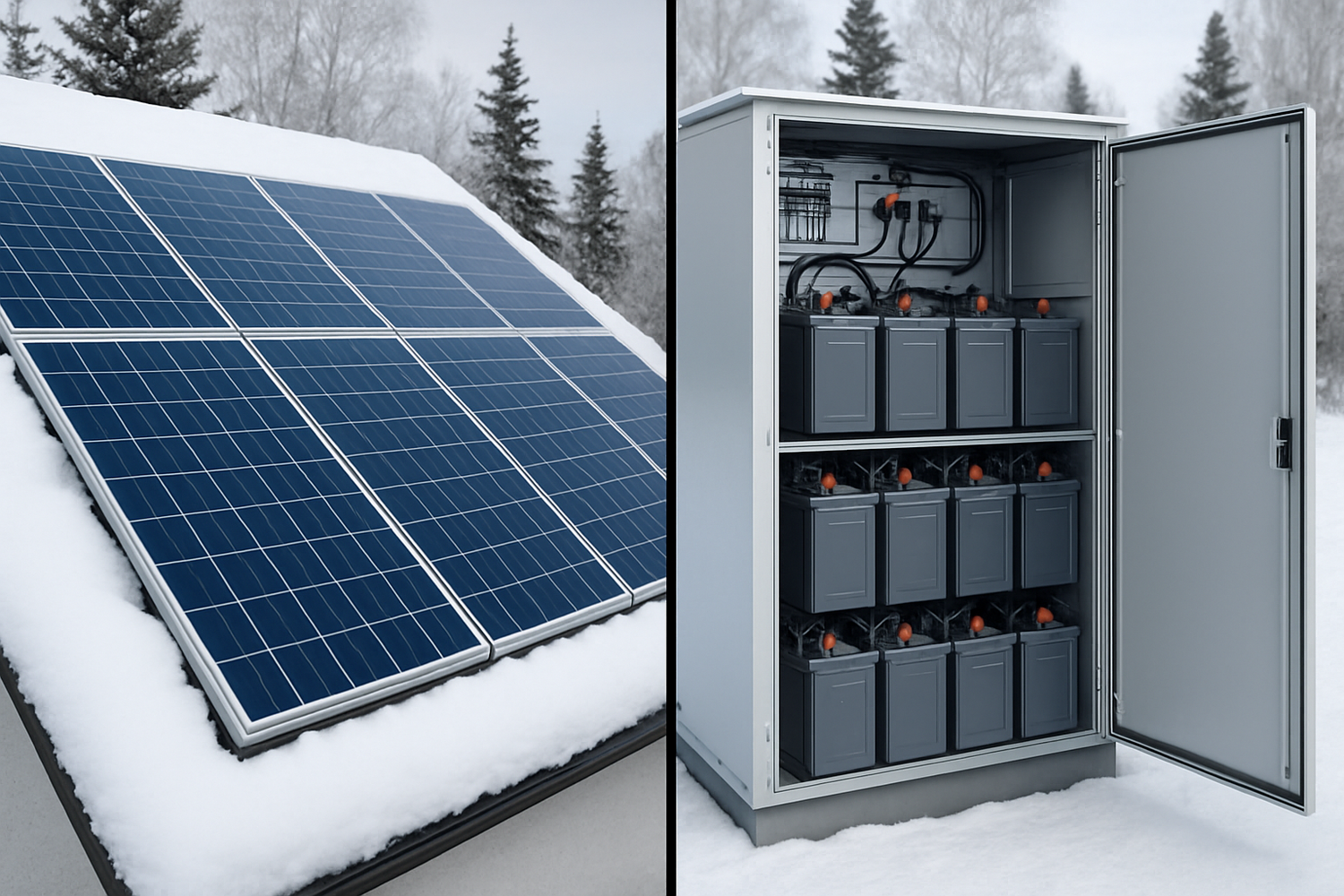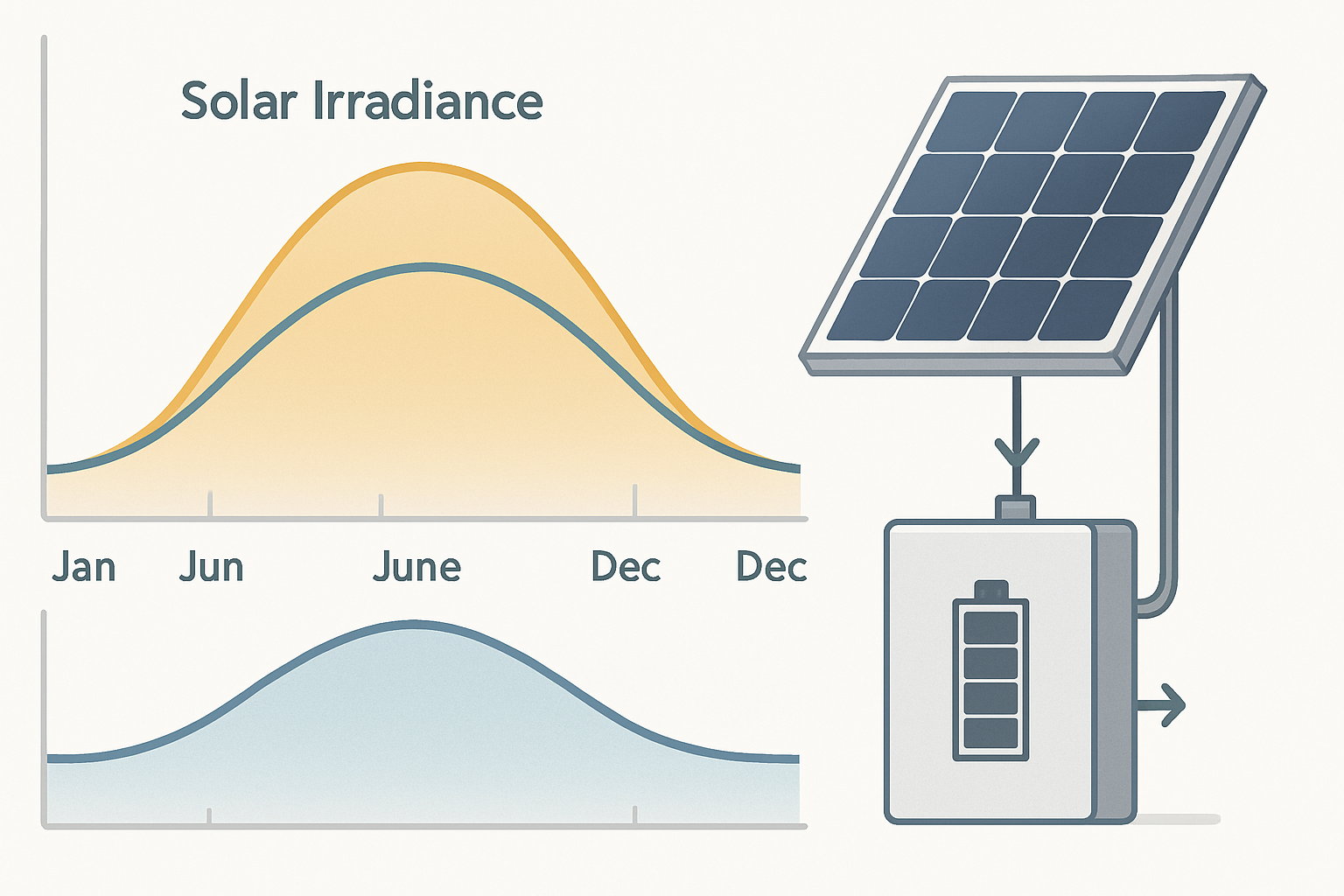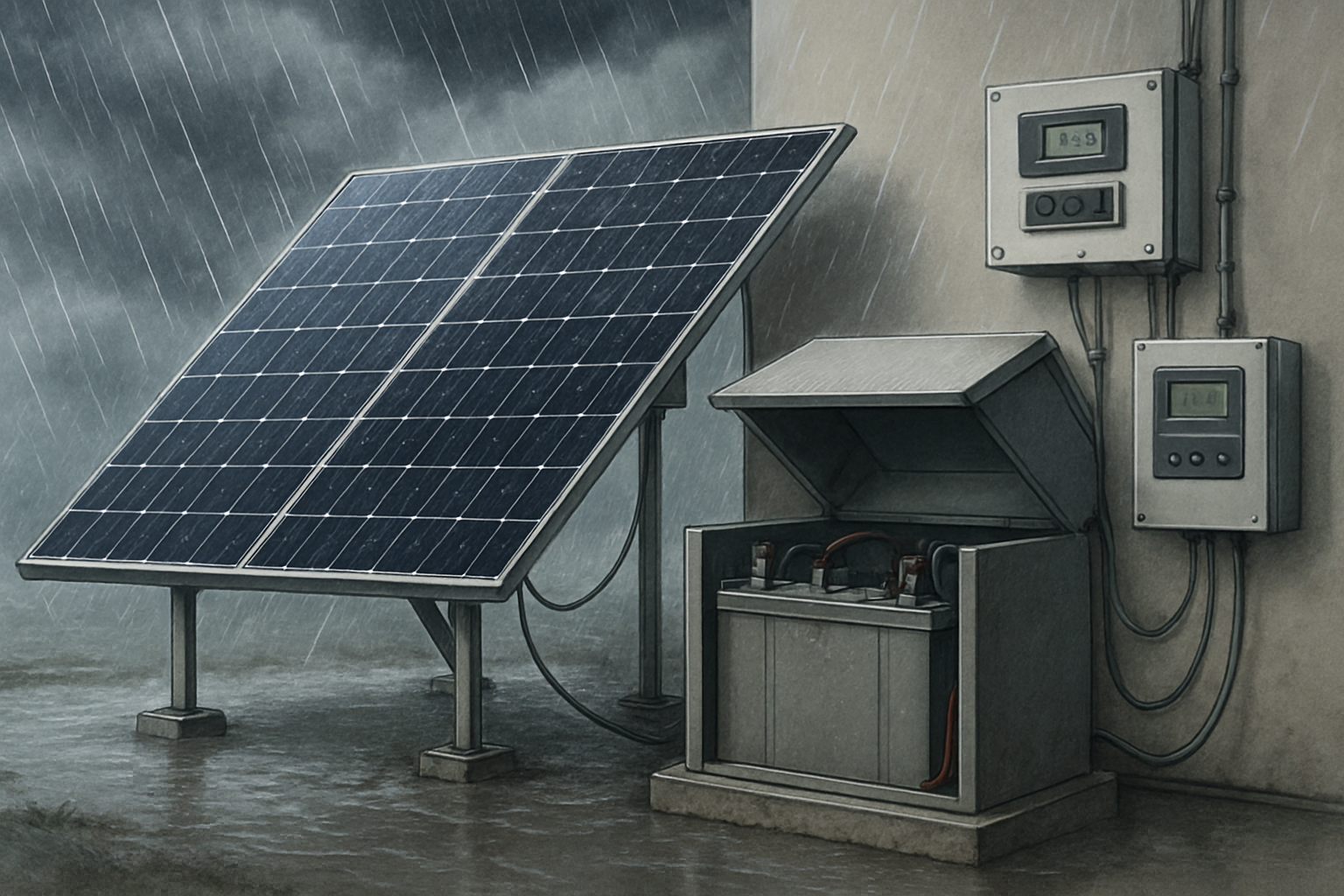Winter poses the ultimate test for solar energy systems. Shorter days, lower sun angles, and frequent cloud cover can slash PV output by 60-80% compared to peak summer production. This seasonal reality forces a critical decision: should you oversize your PV array or invest in additional battery storage to maintain reliable power through the dark months?

The answer isn't straightforward. Each approach offers distinct advantages and trade-offs that depend on your specific location, energy needs, and budget constraints. Understanding these differences can save thousands in system costs while ensuring reliable winter performance.
Understanding Winter Solar Performance Challenges
Winter fundamentally alters solar system dynamics. According to Solar Energy Perspectives, "the possibility of long periods with little solar resource — more frequent in winter — calls for adequate firm capacities." This reality manifests in several ways:
- Reduced daylight hours: December days provide only 8-10 hours of potential sunlight in northern latitudes, compared to 14-16 hours in summer
- Lower sun angles: Winter sun travels a shorter, lower arc across the sky, reducing panel efficiency even during clear conditions
- Weather impacts: Snow cover, ice formation, and persistent cloud cover can eliminate production for days or weeks
- Temperature effects: While cold temperatures can actually improve PV efficiency, the benefits rarely offset reduced irradiance
These factors combine to create what researchers call "dark doldrums" or "dunkelflaute" periods. The IEA's analysis on integrating solar and wind notes that "periods where there is a mismatch between generation and demand may occur more often and last longer" as renewable penetration increases.
Regional Variations in Winter Performance
Winter solar performance varies dramatically by location. Northern regions experience more severe seasonal variations, while southern areas maintain relatively stable production. Key factors include:
| Location Factor | Impact on Winter Production | Mitigation Strategy |
|---|---|---|
| Latitude above 40°N | 70-80% reduction from summer peak | Aggressive oversizing (2-3x summer needs) |
| Snow-prone regions | Complete shutdown for 3-10 days | Steep tilt angles, heated panels |
| Coastal areas | Persistent cloud cover | Extended battery autonomy |
| Mountain regions | Variable weather patterns | Hybrid approach with backup generation |
The Case for Oversizing PV Arrays
Oversizing your PV array means installing significantly more panel capacity than your average daily energy needs would suggest. This strategy leverages the decreasing cost of solar panels to capture maximum energy during brief periods of winter sunlight.
Advantages of PV Oversizing
Cost-effectiveness: Solar panel prices have dropped 85% since 2010, making oversizing increasingly economical. The marginal cost of additional panels often proves lower than equivalent battery capacity.
Maintenance simplicity: PV panels require minimal maintenance and have 25+ year lifespans. Unlike batteries, they don't degrade significantly with cycling or require thermal management.
Peak production capture: During clear winter days, an oversized array can generate substantial power in short timeframes, potentially meeting daily needs in just 4-6 hours of peak sunlight.
Future-proofing: Oversized arrays provide headroom for increased loads, such as electric vehicle charging or heat pump installation.
Optimal Oversizing Ratios
Effective oversizing requires careful calculation based on your worst-case winter scenarios. Typical oversizing ratios include:
- Moderate climates (35-45°N): 1.5-2x summer sizing
- Northern regions (45-55°N): 2-3x summer sizing
- Extreme northern locations (55°N+): 3-4x summer sizing or hybrid systems
The key lies in balancing oversizing costs against the reduced battery requirements. An optimally oversized array should meet 70-80% of winter energy needs during typical clear days.
The Battery Storage Approach
Battery storage takes a different approach, maintaining standard PV sizing while adding sufficient storage capacity to bridge extended low-production periods. Modern LiFePO4 batteries offer the reliability and cycle life necessary for serious winter energy storage.
Battery Storage Advantages
Predictable autonomy: Properly sized battery banks provide known backup duration, regardless of weather conditions. This predictability proves crucial for critical loads.
Load shifting capability: Batteries enable time-shifting of energy consumption, allowing you to use stored summer production during winter months or shift loads to optimal charging windows.
System stability: Battery storage provides consistent voltage and frequency, improving power quality for sensitive electronics and appliances.
Grid independence: Large battery banks can provide complete energy independence for days or weeks, eliminating reliance on backup generators.
Winter Battery Considerations
Cold weather significantly impacts battery performance. Key considerations include:
- Capacity derating: LiFePO4 batteries lose 10-20% capacity at 0°C, with further reductions at lower temperatures
- Charging limitations: Most lithium batteries cannot charge below 0°C without damage, requiring heated enclosures
- Thermal management: Insulated, heated battery enclosures add cost but ensure reliable winter operation
- Depth of discharge: Conservative discharge limits extend battery life during demanding winter cycling
Economic Analysis: PV vs Battery Investment
The economic comparison between PV oversizing and battery expansion depends on several factors, including equipment costs, installation complexity, and long-term maintenance requirements.
Cost Comparison Framework
Consider a typical off-grid home requiring 20 kWh daily in winter:
| Strategy | Equipment Cost | Installation Cost | 20-Year Maintenance | Total Cost |
|---|---|---|---|---|
| Standard + 40kWh Battery | $16,000 | $3,200 | $8,000 | $27,200 |
| 2x Oversized PV + 20kWh Battery | $14,000 | $4,200 | $4,000 | $22,200 |
| 3x Oversized PV + 10kWh Battery | $17,000 | $5,100 | $2,000 | $24,100 |
This analysis reveals that moderate PV oversizing (2x) often provides the best economic value, combining lower total costs with reduced maintenance complexity.
Performance vs Investment Trade-offs
The optimal strategy balances initial investment against long-term reliability. Key considerations include:
- Reliability requirements: Critical loads may justify higher battery investment for guaranteed backup power
- Available space: Roof or ground space limitations may favor battery storage over array expansion
- Local climate: Regions with consistent winter cloud cover benefit more from battery storage than PV oversizing
- Future expansion: Modular battery systems offer easier capacity upgrades than PV array modifications
Hybrid Approaches: Combining Strategies
Many successful winter solar systems combine moderate PV oversizing with strategic battery expansion. This hybrid approach optimizes both daily energy capture and extended autonomy capabilities.
Optimal Hybrid Configurations
Effective hybrid systems typically feature:
- 1.5-2x PV oversizing: Sufficient to meet daily needs during most clear winter days
- 3-5 days battery autonomy: Adequate storage for typical weather patterns
- Smart load management: Automated systems that prioritize essential loads during extended low-production periods
- Backup generation integration: Small generators for extreme weather events lasting beyond battery capacity
This balanced approach provides excellent reliability while maintaining reasonable system costs. The IEA's China Power System Transformation report emphasizes that "diversifying the power mix" improves both environmental and economic outcomes, a principle that applies equally to residential systems.
Smart System Integration
Modern hybrid systems leverage intelligent controls to optimize performance:
- Weather prediction: Systems that adjust charging strategies based on weather forecasts
- Load prioritization: Automatic load shedding during extended low-production periods
- Seasonal optimization: Different operating modes for summer abundance and winter scarcity
- Performance monitoring: Real-time tracking of system efficiency and component health
Making the Right Choice for Your System
The decision between PV oversizing and battery expansion depends on your specific circumstances, priorities, and constraints. Consider these decision factors:
Choose PV oversizing if:
- You have adequate roof or ground space for array expansion
- Your region experiences clear winter days between storm systems
- You prioritize long-term reliability and low maintenance
- Initial budget allows for larger upfront PV investment
Choose battery expansion if:
- Space constraints limit PV array size
- Your region experiences extended periods of overcast weather
- You require guaranteed backup power for critical loads
- You prefer modular system expansion capabilities
Choose a hybrid approach if:
- You want to optimize both daily production and extended autonomy
- Your energy needs vary significantly between seasons
- You're building a system for long-term energy independence
- Budget allows for comprehensive system design
The most successful winter solar systems often combine elements of both strategies, creating resilient, cost-effective solutions that provide reliable power throughout the year. As solar technology continues advancing and costs decline, the optimal balance between PV capacity and battery storage will continue evolving, but the fundamental principles of matching generation capacity to seasonal demand patterns remain constant.
Ultimately, the best approach depends on your specific energy needs, local climate conditions, and long-term reliability requirements. Careful analysis of these factors, combined with professional system design, ensures optimal performance and value from your winter solar investment.





Leave a comment
All comments are moderated before being published.
This site is protected by hCaptcha and the hCaptcha Privacy Policy and Terms of Service apply.